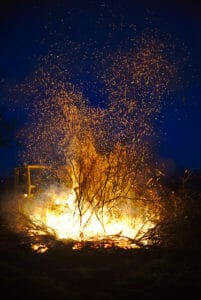There are so many reasons to prioritize consistent Portland tree care: it increases your property value, benefits the environment, and makes your yard more enjoyable. During the dry summer months, fire prevention is yet another reason to take care of your trees. Without regular pruning, trees sport more dead material, which can serve as fire fuel. Read on for our tips on how to prevent property fires through landscape and general home maintenance.
Creating a Landscape that Discourages Fires
—Remove dead plant materials. Dead grasses, bushes, and trees are fire fuel. In rural areas, you may be able to burn dead plants with the proper permitting. In urban zones, add dead plants to your on-site compost, or (in Portland) stick it in your city compost bin.
—Create Defensible Space. Those in rural, especially fire-prone areas should create a 30’ treeless perimeter around their homes with minimal vegetation. This decreases the chance that flames will reach the structure. Additionally, defensible space makes it easier for firefighters to defend the home. Homes on a hill require more defensible space (150’ perimeter), because fire moves more quickly up a slope.
—Remove Roof and Gutter Fire Hazards. Remove dead branches that overhang roofs. Keep gutters and roof valleys clear of grasses and other plant material. A good rule of thumb is to keep branches at least ten feet from your roof.
—Prune shade trees so that lowest limbs are at least six feet off the ground. This minimizes the amount of organic material that’s accessible to ground fires.
—Keep trees healthy; vigorous trees are more likely to survive a fire. Schedule regular Portland tree trimming from certified arborists. Be sure to remove deadwood while pruning.
General Maintenance Tips for Preventing Fires on your Property
Recognize the Signs of a Dry, Stressed Tree. Pay attention to the health of your trees. If you notice the following clues, your tree may be diseased or dead.
• Unusual leaf loss, or a reduction in leaf growth
• Brittle bark that falls off the tree, or cracks in the bark
• Fallen limbs, as well as leafless branches that are spongy or brittle
• Open wounds or soft spots
• Fungus growth (indicates internal rot)
• Twigs that break evenly and cleanly, with a brown interior. A healthy twig will bend, and its interior will be green.
Dying trees are dry trees; as such they constitute a fire hazard. If you discover a dead or dying tree on your property, call us to arrange Portland tree removal.
Grill and Burn Safely. When fire is involved stay alert. Grill safely—keep grills away from deck railings and structures. Gas grills have their own safety requirements; understand your grill and have a plan for putting out unexpected fires. For instance, when grilling you can keep a bucket of water and/or a fire extinguisher handy. The same safety approach applies to bonfires: have a plan for quickly extinguishing the fire, and look out for dry materials overhead. If tree branches droop dangerously over the bonfire area, trim them away before burning.
Maintain emergency vehicle access. Fire trucks cannot access rutted, steep, or poorly maintained roads. Each rural fire district has its own standards for driveways.
Practice interior fire safety. From checking fire alarms to clearing out fireplaces, there are plenty of ways to prevent fires inside your home. Check out the State of Oregon’s Home Fire Safety Checklist for more information.
Thin Lush Vegetation. Fires are a natural, cyclical event in Western forests. When they occur regularly, fires minimize burnable materials. However, since European settlement, fires have been repressed. Less frequent fires means more dead plants are available to burn, so that those fires that do occur tend to be more intense. If your property is thick with growth, consider controlled burning to reduce the amount of fire fuel on the ground.
If you have questions about your property, you can always get in touch with Urban Forest Pro. Our Portland certified arborists are happy to visit your home and suggest effective approaches for minimizing fire danger in your landscape.